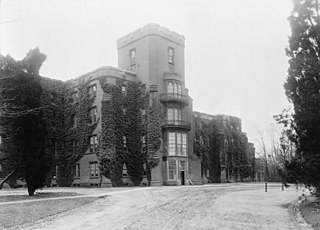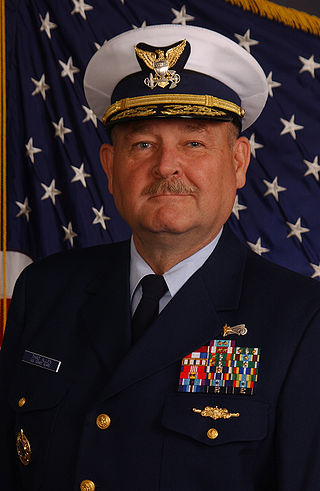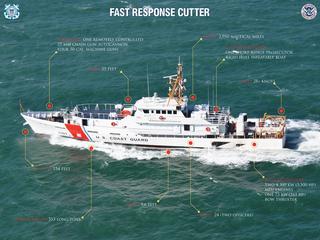
The United States Coast Guard (USCG) is the maritime security, search and rescue, and law enforcement service branch of the United States Armed Forces and one of the country's eight uniformed services. The service is a maritime, military, multi-mission service unique among the United States military branches for having a maritime law enforcement mission with jurisdiction in both domestic and international waters and a federal regulatory agency mission as part of its duties. It is the largest and most powerful coast guard in the world, rivaling the capabilities and size of most navies.

St. Elizabeths Hospital is a psychiatric hospital in Southeast, Washington, D.C. operated by the District of Columbia Department of Behavioral Health. It opened in 1855 under the name Government Hospital for the Insane, the first federally operated psychiatric hospital in the United States. Housing over 8,000 patients at its peak in the 1950s, the hospital had a fully functioning medical-surgical unit, a school of nursing, accredited internships and psychiatric residencies. Its campus was designated a National Historic Landmark in 1990.

The United States Department of Homeland Security (DHS) is the U.S. federal executive department responsible for public security, roughly comparable to the interior or home ministries of other countries. Its stated missions involve anti-terrorism, border security, immigration and customs, cyber security, and disaster prevention and management.

James Milton Loy is a retired admiral of the United States Coast Guard who served as the acting U.S. Secretary of Homeland Security in 2005 and U.S. Deputy Secretary of Homeland Security (DHS) from November 4, 2003, to March 1, 2005. Prior to his appointment as deputy secretary, he served as the second administrator of the Transportation Security Administration from 2002 to 2003, and before that as the commandant of the U.S. Coast Guard from 1998 to 2002. Also in 2004, Loy was elected as a fellow of the National Academy of Public Administration.

The United States Coast Guard Auxiliary is the civilian uniformed volunteer component of the United States Coast Guard. Congress established the unit on 23 June 1939, as the United States Coast Guard Reserve. On 19 February 1941, the organization was re-designated as the United States Coast Guard Auxiliary. The Auxiliary exists to support all USCG missions on the water or in the air, except for roles that require "direct" law enforcement or military engagement. As of 2022, there were approximately 21,000 members of the U.S. Coast Guard Auxiliary.

The Gold Lifesaving Medal and Silver Lifesaving Medal are U.S. decorations issued by the United States Coast Guard. The awards were established by Act of Congress, 20 June 1874; later authorized by 14 U.S.C. § 500. These decorations are two of the oldest medals in the United States and were originally established at the Department of Treasury as Lifesaving Medals First and Second Class. The Department of the Treasury initially gave the award, but today the United States Coast Guard awards it through the Department of Homeland Security. They are not classified as military decorations, and may be awarded to any person.
The Special Operations Service Ribbon is a service award of the United States Coast Guard which was first created 1 July 1987 by order of Commandant of the Coast Guard, Admiral Paul A. Yost Jr. The award is authorized for certain acts of non-combat meritorious service, for which no other service medal or ribbon is authorized.

Douglas Albert Munro was a United States Coast Guardsman who was posthumously decorated with the Medal of Honor for an act of "extraordinary heroism" during World War II. He is the only person to have received the medal for actions performed during service in the Coast Guard.
The United States military inter-service awards and decorations are those medals and ribbons which may be awarded to all members of the six military branches of the U.S. Armed Forces. Each military department awards inter-service awards under the same criteria.

Thad William Allen is a former admiral of the United States Coast Guard who served as the 23rd commandant from 2006 to 2010. Allen is best known for his widely praised performance directing the federal response to hurricanes Katrina and Rita in the Gulf Coast region from September 2005 to January 2006, and for his role as National Incident Commander of the Unified Command for the Deepwater Horizon oil spill in the Gulf of Mexico in 2010. Robert J. Papp Jr. succeeded him as Commandant on 25 May 2010.

Coast Guard Intelligence (CGI) is the military intelligence branch of the United States Coast Guard, and a component of the Central Security Service of the United States Department of Defense.

The Sentinel-class cutter, also known as Fast Response Cutter due to its program name, is part of the United States Coast Guard's Deepwater program. At 154 feet (46.8 m) it is similar to, but larger than the 123-foot (37 m) lengthened 1980s-era Island-class patrol boats that it replaces. Up to 58 vessels are to be built by the Louisiana-based firm Bollinger Shipyards, using a design from the Netherlands-based Damen Group, with the Sentinel design based on the company's Damen Stan 4708 patrol vessel. The Department of Homeland Security's budget proposal to Congress, for the Coast Guard, for 2021, stated that, in addition to 58 vessels to serve the Continental US, they requested an additional six vessels for its portion of Patrol Forces South West Asia.

The Coast Guard Judge Advocate General oversees the delivery of legal services to the United States Coast Guard, through the Office of the Judge Advocate General in Washington, the Legal Service Command, offices in the Atlantic and Pacific Areas, nine Coast Guard Districts, the Coast Guard Academy, three training centers, and a number of other activities and commands. Legal services are delivered by Coast Guard judge advocates and civilian counsel in ten legal practice areas: criminal law/military justice, operations, international activities, civil advocacy, environmental law, procurement law, internal organizational law, regulations and administrative law, legislative support and legal assistance.
This article covers the organization of the United States Coast Guard.

The Homeland Security Distinguished Service Medal is a military decoration of the Department of Homeland Security, which is presented to United States Armed Forces servicemembers for exceptionally meritorious service. The current version of the medal was established in February 2003, retroactive to March 1, 2002.

USCGC Munro (WMSL-755) is the sixth Legend-class cutter of the United States Coast Guard. Munro is the second cutter named for Signalman First Class Douglas A. Munro (1919–1942), the only Coast Guardsman to be awarded the Medal of Honor. The US Navy destroyer escort USS Douglas A. Munro (DE-422) was also named for Munro.

Karl Leo Schultz is a retired United States Coast Guard admiral who served as the 26th Commandant of the Coast Guard from 2018 to 2022.

The following January 2019 order of battle is for the United States Coast Guard.

The South Capital Street Limited Line, designated Route W9, was a bus route operated by the Washington Metropolitan Area Transit Authority between L'Enfant Plaza station of the Blue, Yellow, Orange, Green, and Silver lines of the Washington Metro and the Douglas A. Munro Coast Guard Headquarters Building or Livingston. The line operated during the weekday peak-hours only providing service from the Coast Guard Headquarters to L'Enfant Plaza. The line was discontinued on June 24, 2018 due to low ridership and the U.S. Coast Guard ending their subsidy for the W9 on July 1, 2018.

Melissa Bert serves as the Judge Advocate General and Chief Counsel of the United States Coast Guard. Rear Admiral (RADM) Bert is the first woman to serve in this position. Prior flag assignments held by RADM Bert include the U.S. Coast Guard’s Director of Governmental and Public Affairs and Deputy Director of Operations for U.S. Northern Command.




















